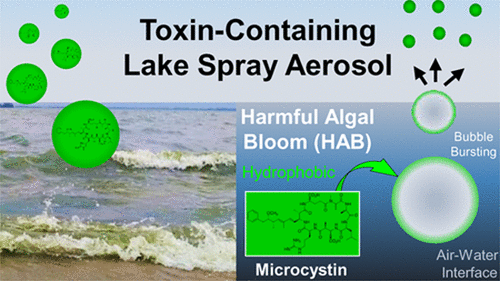当前位置:
X-MOL 学术
›
Environ. Sci. Technol.
›
论文详情
Our official English website, www.x-mol.net, welcomes your feedback! (Note: you will need to create a separate account there.)
Harmful Algal Bloom Toxins in Aerosol Generated from Inland Lake Water.
Environmental Science & Technology ( IF 11.4 ) Pub Date : 2020-03-31 , DOI: 10.1021/acs.est.9b07727 Nicole E Olson 1 , Madeline E Cooke 1 , Jia H Shi 1 , Johnna A Birbeck 2 , Judy A Westrick 2 , Andrew P Ault 1
Environmental Science & Technology ( IF 11.4 ) Pub Date : 2020-03-31 , DOI: 10.1021/acs.est.9b07727 Nicole E Olson 1 , Madeline E Cooke 1 , Jia H Shi 1 , Johnna A Birbeck 2 , Judy A Westrick 2 , Andrew P Ault 1
Affiliation

|
Harmful algal blooms (HABs) caused by cyanobacteria in freshwater environments produce toxins (e.g., microcystin) that are harmful to human and animal health. HAB frequency and intensity are increasing with greater nutrient runoff and a warming climate. Lake spray aerosol (LSA) released from freshwater lakes has been identified on lakeshores and after transport inland, including from lakes with HABs, but little is known about the potential for HAB toxins to be incorporated into LSA. In this study, freshwater samples were collected from two lakes in Michigan: Mona Lake during a severe HAB with microcystin concentrations (>200 μg/L) well above the Environmental Protection Agency (EPA) recommended "do not drink" level (1.6 μg/L) and Muskegon Lake without a HAB (<1 μg/L microcystin). Microcystin toxins were identified in freshwater, as well as aerosol particles generated in the laboratory from Mona Lake water by liquid chromatography-tandem mass spectrometry (LC-MS/MS) at atmospheric concentrations up to 50 ± 20 ng/m3. Enrichment of hydrophobic microcystin congeners (e.g., microcystin-LR) was observed in aerosol particles relative to bulk freshwater, while enrichment of hydrophilic microcystin (e.g., microcystin-RR) was lower. As HABs increase in a warming climate, understanding and quantifying the emissions of toxins into the atmosphere is crucial for evaluating the health consequences of HABs.
中文翻译:

内陆湖水产生的气溶胶中有害藻华毒素。
在淡水环境中,由蓝细菌引起的有害藻华(HABs)产生对人体和动物健康有害的毒素(例如微囊藻毒素)。随着更多的养分径流和气候变暖,HAB的频率和强度不断增加。从淡水湖中释放出的湖喷雾气溶胶(LSA)已在湖岸和内陆运输后被确认,包括从具有HAB的湖泊中释放,但对于将HAB毒素掺入LSA的潜力知之甚少。在这项研究中,从密歇根州的两个湖中采集了淡水样品:严重的HAB期间的蒙娜湖,其微囊藻毒素浓度(> 200μg/ L)远高于环境保护署(EPA)推荐的“不饮酒”水平(1.6μg/ L)和没有HAB(<1μg/ L微囊藻毒素)的马斯基根湖。在淡水中发现了微囊藻毒素,以及实验室中通过液相色谱-串联质谱法(LC-MS / MS)从莫娜湖水中产生的气溶胶颗粒,大气浓度最高为50±20 ng / m3。相对于大量淡水,在气溶胶颗粒中观察到了疏水性微囊藻毒素同源物(例如,微囊藻毒素-LR)的富集,而亲水性微囊藻毒素(例如,微囊藻毒素-RR)的富集度较低。随着HAB在气候变暖中的增加,了解和量化向大气中释放的毒素对于评估HAB对健康的影响至关重要。相对于大量淡水,在气溶胶颗粒中观察到了微囊藻毒素-LR),而亲水性微囊藻毒素(例如,微囊藻毒素-RR)的富集度较低。随着HAB在气候变暖中的增加,了解和量化向大气中释放的毒素对于评估HAB对健康的影响至关重要。相对于大量淡水,在气溶胶颗粒中观察到了微囊藻毒素-LR),而亲水性微囊藻毒素(例如,微囊藻毒素-RR)的富集度较低。随着HAB在气候变暖中的增加,了解和量化向大气中释放的毒素对于评估HAB对健康的影响至关重要。
更新日期:2020-04-23
中文翻译:

内陆湖水产生的气溶胶中有害藻华毒素。
在淡水环境中,由蓝细菌引起的有害藻华(HABs)产生对人体和动物健康有害的毒素(例如微囊藻毒素)。随着更多的养分径流和气候变暖,HAB的频率和强度不断增加。从淡水湖中释放出的湖喷雾气溶胶(LSA)已在湖岸和内陆运输后被确认,包括从具有HAB的湖泊中释放,但对于将HAB毒素掺入LSA的潜力知之甚少。在这项研究中,从密歇根州的两个湖中采集了淡水样品:严重的HAB期间的蒙娜湖,其微囊藻毒素浓度(> 200μg/ L)远高于环境保护署(EPA)推荐的“不饮酒”水平(1.6μg/ L)和没有HAB(<1μg/ L微囊藻毒素)的马斯基根湖。在淡水中发现了微囊藻毒素,以及实验室中通过液相色谱-串联质谱法(LC-MS / MS)从莫娜湖水中产生的气溶胶颗粒,大气浓度最高为50±20 ng / m3。相对于大量淡水,在气溶胶颗粒中观察到了疏水性微囊藻毒素同源物(例如,微囊藻毒素-LR)的富集,而亲水性微囊藻毒素(例如,微囊藻毒素-RR)的富集度较低。随着HAB在气候变暖中的增加,了解和量化向大气中释放的毒素对于评估HAB对健康的影响至关重要。相对于大量淡水,在气溶胶颗粒中观察到了微囊藻毒素-LR),而亲水性微囊藻毒素(例如,微囊藻毒素-RR)的富集度较低。随着HAB在气候变暖中的增加,了解和量化向大气中释放的毒素对于评估HAB对健康的影响至关重要。相对于大量淡水,在气溶胶颗粒中观察到了微囊藻毒素-LR),而亲水性微囊藻毒素(例如,微囊藻毒素-RR)的富集度较低。随着HAB在气候变暖中的增加,了解和量化向大气中释放的毒素对于评估HAB对健康的影响至关重要。


























 京公网安备 11010802027423号
京公网安备 11010802027423号